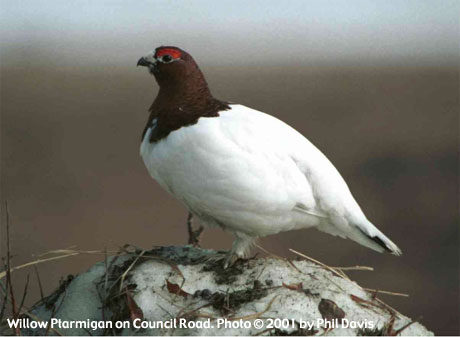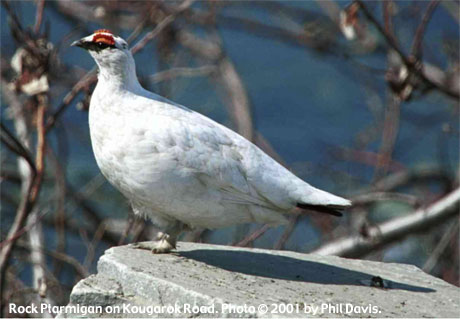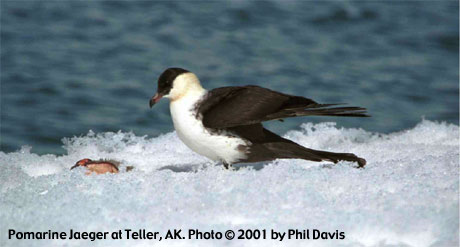
NOME
Air Travel: Gambell to Nome, Thursday, May 31: Although the Gambell weather looked terrible in the morning, the ceiling lifted as the day proceeded and by 3:30 pm the word was spread, "planes were on their way". At Gambell, the air carriers must be able to see the top of the local 600-foot mountain before they will land—local flight conditions are strictly VFR. Five planes arrived within about 30 minutes and there was major congestion on the tarmac. Soon, away we went, with more great looks of Siberia as we departed. One of our group, Jim Buckley, pointed out to us that since today was May 31st and we were looking across the International Date Line, only 7-8 miles offshore from Gambell, we were actually "looking into June". Cool!
Nome Background: Nome is located on Norton Sound on the south side of the Seward Peninsula (not to be confused with the town of Seward on the Kenai Peninsula, south of Anchorage). The "strike it rich" gold rush of the early 1900s attracted over 20,000 people to Nome; however, today the current population is about 3,500. Gold panners still stake out claims on the shore where the rivers and creeks empty into Norton Sound.

Birding Nome: To bird the Nome area, one follows the three roads that lead out of town and head north into the Seward Peninsula. These roads and the local roads around town provide about 250 miles of birding access, if all roads are open.
Weather/Daylight: The average Nome June high temperature is 53 (F) and the average low is 39. On June 1, the sun sets at 1:14 am and rises at 4:48 am. Twilight never ceases, so there is always daylight.
Accommodations: The birding world converges at Nome in the first week of June—every tour operator seemed to be there, as well as many independent birders. There are a few hotels, but the town fills up. The logistics of hotel rooms and rental vehicles require consideration and planning.
Food: There are several decent restaurants in town.
Wildlife: During our stay we were treated to good looks of musk oxen (including one very close), moose (including a mother suckling two young), large flocks of reindeer, and a grizzly bear.
Nome References:
"I Love Alaska—Nome":
http://www.ilovealaska.com/alaska/Nome/
"There’s no place like Nome":
http://www.alaska.net/~nome/
Nome Convention (huh?) and Visitors Bureau:
http://www.nomealaska.org/
Nome Birding Chronology:
May 31, Thursday, Nome: Arriving at Nome, we heard the latest word on the roads: Teller Road was open all the way; Kougarok Road was open only to mile 38, well shy of the Curlew and White Wagtail nesting areas; and Council Road was closed at about mile 11, well short of Safety Lagoon where we hoped to see the Aleutian Tern. Yikes!
That evening, we birded out Council Road as far as we could, seeing many WILLOW PTARMIGANS perched on the snow banks. In Norton Sound, we saw an EMPEROR GOOSE flying by with several Brant. ARCTIC TERNS were common. We also found a very cold looking, rare (for Nome), Osprey. Semipalmated and Western Sandpipers were displaying prominently.


June 1, Friday, Nome: While waiting for the 7 am opening of our breakfast restaurant, Fat Freddy’s, we were treated to a repeat performance from Gambell … another, very pink, first summer ROSS’S GULL flew by in Norton Sound, giving everyone distant but more great looks. SABINE’S GULLS were also present.
Up Kougarok Road, we found a BLUETHROAT for a brief look and a Northern Shrike. ROCK PTARMIGAIN were found in abundance up this road, allowing close approaches for photography. Both Cliff and Bank Swallows were present.
June 2, Saturday, Nome: We took Teller Road all the way to Teller, but the side road to Wooley Lagoon was washed out near the village. Perching LONG-TAILED JAEGERS provide more good looks and photo opportunities and all three large plovers were present. Many seabirds were in the water at Teller, including both guillemots. We did not find any White Wagtails in the town of Teller at the traditional location.

June 3, Sunday, Nome: Late the night before, we learned that Council Road to Safety Lagoon had just opened. So, in the morning, we first again tried Kougarok Road and found another very cooperative BLUETHROAT that gave everyone great looks. We carefully searched for Gyrfalcon nests, however, stops at three or four previous nest sites yielded only nesting GOLDEN EAGLES and ROUGH-LEGGED HAWKS. No Gyrs.
On the road to Safety Lagoon, at the mouth of the Nome River, we watched two EMPEROR GEESE and an IVORY GULL. At Safety Sound, alerted by their musical calls, we had quick overhead looks of ALEUTIAN TERNS in flight and then excellent looks at one that landed on the beach, right in front of us. We took Council Road only as far as the town of Solomon, on the east side of the Lagoon. We surmised that the road was probably not open much further. In milder years, the road would take us to the boreal forests near the town of Council and provide additional species for the trip list.
General Nome Birding Notes: Common Snipe (delicata) were very vocal. All three jaegers were active and provided great looks. Tree Swallows were active along this road and in town. Gray-cheeked Thrushes and Northern Waterthrushes vocalized everywhere. The common warblers included Orange-crowned, Yellow, and Wilson’s. Several YELLOW WAGTAILS were present. Common sparrows included American Tree, Savannah, Fox, and Golden-crowned. Lapland Longspurs were abundant and a number of Snow Buntings were on territory. Both redpolls were seen and a few Rusty Blackbirds were observed.
June 4, Monday, Nome: Another group told us that they had a spotted a flyover ARCTIC WARBLER at mile 11 on Kougarok Road the day before. Today, we tried the same spot and were rewarded with killer looks of a bird vocalizing on territory. Our one last try for a Gyrfalcon was unsuccessful.
June 4, Monday, Nome to Anchorage to Washington, DC: Shortly after noon, we departed for Anchorage and then connected to a red-eye back to the Washington, DC area.
Trip Summary: We left home with a target list of 12 species and found all of them except the Gyrfalcon, probably the "lowest priority" bird on our list. However, we’ll take the Eurasian Bullfinch as a substitute any day!.
Phil Davis
Davidsonville, MD
pdavis@ix.netcom.com